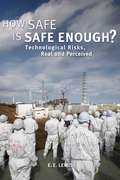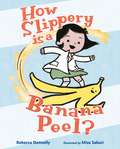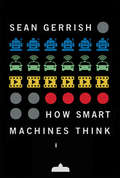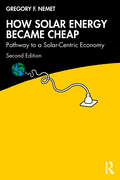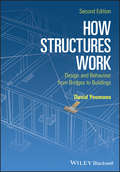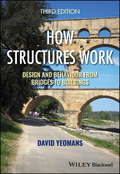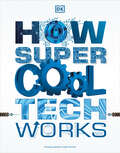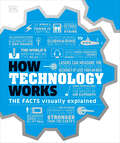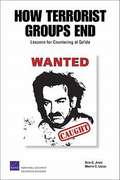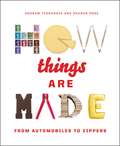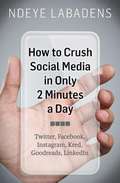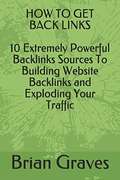- Table View
- List View
How Professionals Make Decisions (Expertise: Research and Applications Series)
by Raanan Lipshitz Henry Montgomery Berndt BrehmerThis volume is the fruit of the 5th conference on Naturalistic Decision Making which focused on the importance of studying people who have some degree of expertise in the domain in which they make decisions. The substantive concerns pertain to how individuals and groups make decisions in professional and organizational settings, and to develop suit
How Round Is Your Circle?: Where Engineering and Mathematics Meet
by Chris Sangwin John BryantHow do you draw a straight line? How do you determine if a circle is really round? These may sound like simple or even trivial mathematical problems, but to an engineer the answers can mean the difference between success and failure. How Round Is Your Circle? invites readers to explore many of the same fundamental questions that working engineers deal with every day--it's challenging, hands-on, and fun. John Bryant and Chris Sangwin illustrate how physical models are created from abstract mathematical ones. Using elementary geometry and trigonometry, they guide readers through paper-and-pencil reconstructions of mathematical problems and show them how to construct actual physical models themselves--directions included. It's an effective and entertaining way to explain how applied mathematics and engineering work together to solve problems, everything from keeping a piston aligned in its cylinder to ensuring that automotive driveshafts rotate smoothly. Intriguingly, checking the roundness of a manufactured object is trickier than one might think. When does the width of a saw blade affect an engineer's calculations--or, for that matter, the width of a physical line? When does a measurement need to be exact and when will an approximation suffice? Bryant and Sangwin tackle questions like these and enliven their discussions with many fascinating highlights from engineering history. Generously illustrated, How Round Is Your Circle? reveals some of the hidden complexities in everyday things.
How Safe is Safe Enough?: Technological Risks, Real and Perceived
by E. E. LewisEvery time an airplane crashes, a gas line explodes, a bridge collapses, or a contaminant escapes the public questions whether the benefits that technology brings are worth its risks. Written in laymen's language, How Safe Is Safe Enough? explores the realities of the risks that technology presents and the public's perceptions of them. E. E. Lewis examines how these perceptions are reconciled with economic interests and risk assessors' analyses in messy and often contentious political processes that determine acceptable levels of safety-levels that often depend more on the perceived nature of the risks than on the number of deaths or injuries that they cause. The author explains why things fail and why design necessitates tradeoffs between performance, cost, and safety. He details methods for identifying and eliminating design flaws and illustrates the consequences when they fail. Lewis examines faulty machine interfaces that cause disastrous human errors and highlights how cost cutting and maintenance neglect have led to catastrophic consequence.How Safe Is Safe Enough? explores how society determines adequate levels of safety, outlining the announcement and enforcement of safety regulations and addressing controversies surrounding cost-benefit analysis. The author argues that large regulatory effects stem from the public's wide-ranging perceptions of three classes of accidents: the many everyday accidents causing one or two deaths at a time, rare disasters causing large loss of life, and toxic releases leading to uncertain future health risks. The nuclear disaster at Fukushima culminates the discussion, exemplifying the dichotomies faced in reconciling professional risk assessors' statistical approaches with the citizenry's fears and perceptions. For better or worse, technology permeates our lives, and much of it we don't understand-how it works and what the chances are that it will fail dangerously. Such interest and concerns are at the heart of this authoritative, provocative analysis.
How Science Runs: Impressions from a Scientific Career
by Eric J. MittemeijerThis book offers a considered yet entertaining reflection on the progress of modern scientific research. The winding path of science can only be understood by revealing the personal, human side of scientific research, demystifying the actions of the scientist and exposing the human drama on the stage of science. The book looks at the true nature of contemporary science and scientists through the lens of the personal experiences of the author, a renowned and leading materials scientist, over the last half century. It examines the positive threads of modern scientific progress in sober juxtaposition to the manifest negative developments arising from stiff competition within the current academic landscape. A collection of stories and real-life anecdotes is presented in parallel to the career of the author, providing a first-hand account of important achievements in the field of materials science. As a result, this book provides fascinating reading for students, seasoned scientists, and anybody else interested in the workings and machinations of modern science.
How Science Works: Exploring effective pedagogy and practice
by Rob ToplisHow Science Works provides student and practising teachers with a comprehensive introduction to one of the most dramatic changes to the secondary science curriculum.? Underpinned by the latest research in the field, it explores the emergence and meaning of How Science Works and reviews major developments in pedagogy and practice. With chapters structured around three key themes - why How Science Works, what it is and how to teach it – expert contributors explore issues including the need for curriculum change, arguments for scientific literacy for all, school students’ views about science, what we understand about scientific methods, types of scientific enquiry, and, importantly, effective pedagogies and their implications for practice. Aiming to promote discussion and reflection on the ways forward for this new and emerging area of the school science curriculum, it considers: teaching controversial issues in science argumentation and questioning for effective teaching enhancing investigative science and developing reasoned scientific judgments the role of ICT in exploring How Science Works teaching science outside the classroom. How Science Works is a source of guidance for all student, new and experienced teachers of secondary science, interested in investigating how the curriculum can provide creativity and engagement for all school students.
How Slippery Is a Banana Peel?
by Rebecca DonnellyRebecca Donnelly's How Slippery Is a Banana Peel? is a picture book companion to Cats Are a Liquid celebrating the science and the slipperiness of banana peels—a perfect introduction to friction, featuring illustrations by Misa Saburi.Volcanoes roar,But banana peels race.Rockets soar,Like bananas through space.A group of kid-experimenters at a science fair explore the slipperiness of banana peels—a perfect introduction to scientific concepts! It's funny and STEM-inspired, with back matter on friction and a kitchen science experiment. These playful and mischievous banana peels will capture the imagination of readers.
How Smart Is Your City?: Technological Innovation, Ethics and Inclusiveness (Intelligent Systems, Control and Automation: Science and Engineering #98)
by Maria Isabel Aldinhas FerreiraThis book focuses on the potential benefits that the so-called smart technologies have been bringing to the urban reality and to the management and governance of the city, simultaneously highlighting the necessity for its responsible and ethically guided deployment, respecting essential humanistic values. The urban ecosystem has been, in the last decades, the locus to where the most advanced forms of technological innovation converge, creating intelligent management platforms meant to produce models of energy, water consumption, mobility/transportation, waste management and efficient cities. Due to the coincidence of the punctual overlap of its own genesis with the pandemics outbreak, the present book came to embody both the initial dream and desire of an intelligent city place of innovation, development and equity – a dream present in most of the chapters – and the fear not just of the pandemics per se, but of the consequences that this may have for the character of the intelligent city and for the nature of its relationship with its dwellers that, like a mother, it is supposed to nurture, shelter and protect.
How Smart Machines Think (The\mit Press Ser.)
by Sean GerrishEverything you've always wanted to know about self-driving cars, Netflix recommendations, IBM's Watson, and video game-playing computer programs.The future is here: Self-driving cars are on the streets, an algorithm gives you movie and TV recommendations, IBM's Watson triumphed on Jeopardy over puny human brains, computer programs can be trained to play Atari games. But how do all these things work? In this book, Sean Gerrish offers an engaging and accessible overview of the breakthroughs in artificial intelligence and machine learning that have made today's machines so smart.Gerrish outlines some of the key ideas that enable intelligent machines to perceive and interact with the world. He describes the software architecture that allows self-driving cars to stay on the road and to navigate crowded urban environments; the million-dollar Netflix competition for a better recommendation engine (which had an unexpected ending); and how programmers trained computers to perform certain behaviors by offering them treats, as if they were training a dog. He explains how artificial neural networks enable computers to perceive the world—and to play Atari video games better than humans. He explains Watson's famous victory on Jeopardy, and he looks at how computers play games, describing AlphaGo and Deep Blue, which beat reigning world champions at the strategy games of Go and chess. Computers have not yet mastered everything, however; Gerrish outlines the difficulties in creating intelligent agents that can successfully play video games like StarCraft that have evaded solution—at least for now. Gerrish weaves the stories behind these breakthroughs into the narrative, introducing readers to many of the researchers involved, and keeping technical details to a minimum. Science and technology buffs will find this book an essential guide to a future in which machines can outsmart people.
How Solar Energy Became Cheap: A Model for Low-Carbon Innovation
by Gregory F. NemetSolar energy is a substantial global industry, one that has generated trade disputes among superpowers, threatened the solvency of large energy companies, and prompted serious reconsideration of electric utility regulation rooted in the 1930s. One of the biggest payoffs from solar’s success is not the clean inexpensive electricity it can produce, but the lessons it provides for innovation in other technologies needed to address climate change. Despite the large literature on solar, including analyses of increasingly detailed datasets, the question as to how solar became inexpensive and why it took so long still remains unanswered. Drawing on developments in the US, Japan, Germany, Australia, and China, this book provides a truly comprehensive and international explanation for how solar has become inexpensive. Understanding the reasons for solar’s success enables us to take full advantage of solar’s potential. It can also teach us how to support other low-carbon technologies with analogous properties, including small modular nuclear reactors and direct air capture. However, the urgency of addressing climate change means that a key challenge in applying the solar model is in finding ways to speed up innovation. Offering suggestions and policy recommendations for accelerated innovation is another key contribution of this book. This book will be of great interest to students and scholars of energy technology and innovation, climate change and energy analysis and policy, as well as practitioners and policymakers working in the existing and emerging energy industries.
How Solar Energy Became Cheap: Pathway to a Solar-Centric Economy
by Gregory F. NemetThe climate problem is getting worse, but the solutions are getting better. So far, no technology has done more to improve the solutions available to address climate change than solar photovoltaics (PV). This revised edition describes an array of driving forces leading us toward a solar-centric energy system, one where solar power lies at the core rather than at the edge.Now in its second edition the book focuses on the future of solar, taking into account important changes since it was first published. It includes discussions on further growth and cost reductions, industrial policy, and grid integration of high solar. It has been fully revised to include the most recent data available, and includes two new chapters on India, the most important solar market in the Global South, and Australia, the fastest growing market for rooftop solar. The book concludes with a new chapter on a solar-centric economy. The costs of solar PV modules have reduced significantly since they were first commercialized and, in sunny places, are now cheaper than any other form of electricity. Drawing on developments in the US, Japan, Germany, Australia, India, and China, the book analyses the evolution and success of PV and asks how it can serve as a model for other low-carbon technologies, which require urgent innovation to address climate change.It will be of great interest to students and scholars of energy technology and innovation, climate change and energy analysis and policy, as well as practitioners and policymakers working in the energy industries.
How Space Works: The Facts Visually Explained (DK How Stuff Works)
by DKEmbark on an awe-inspiring and informative journey through our Solar System and beyond in this illuminating astronomy book! Discover how big the Universe is, why our view of the sky is constantly changing, what came before the Big Bang, and so much more in 3... 2... 1…. Blast Off! Inside the pages of this comprehensive guide to astronomy for beginners, you&’ll discover: • Simple text and step-by-step graphics that make astronomy easy to understand • Fun facts and tip-of-the-tongue questions are presented through bite-sized factoids and question-and-answer features • Clear explanations demystifying more advanced topics such as cosmic rays, dark matter, and black hole collisions Take a peek at what lies beyond the stratosphereThis out-of-this-world reference book about space introduces you to the weird and wonderful discipline of astronomy and space exploration. From the structure of the Milky Way to the Earth&’s nearest celestial body, the Moon, How Space Works takes you on an unforgettable tour through the stars and galaxies, and to the furthest reaches of space!Answering all your burning questions about space, from ancient white dwarf stars to the Mars Rover, this visual guide explains the essentials of astronomy through bold graphics and step-by-step artworks. It&’s the ultimate book for armchair astronomers and space-technology enthusiasts looking for reliable and up-to-date facts and explanations.Don&’t let the learning stop - try the rest of the series!DK's How Things Work series uses dynamic graphics and jargon-free text to explain the modern world simply and clearly. Packed with fascinating facts and stats, these visual guides cover everything from science to philosophy, making complex topics more accessible than ever before!
How Structures Work
by David YeomansStructural engineering is central to the design of a building. How the building behaves when subjected to various forces - the weight of the materials used to build it, the weight of the occupants or the traffic it carries, the force of the wind etc - is fundamental to its stability. The alliance between architecture and structural engineering is therefore critical to the successful design and completion of the buildings and infrastructure that surrounds us. Yet structure is often cloaked in mathematics which many architects and surveyors find difficult to understand. How Structures Work has been written to explain the behaviour of structures in a clear way without resorting to complex mathematics. This new edition includes a new chapter on construction materials, and significant revisions to, and reordering of the existing chapters. It is aimed at all who require a good qualitative understanding of structures and their behaviour, and as such will be of benefit to students of architecture, architectural history, building surveying and civil engineering. The straightforward, non-mathematical approach ensures it will also be suitable for a wider audience including building administrators, archaeologists and the interested layman.
How Structures Work: Design and Behaviour from Bridges to Buildings
by David YeomansHOW STRUCTURES WORK DESIGN AND BEHAVIOUR FROM BRIDGES TO BUILDINGS, THIRD EDITION DAVID YEOMANS Structural engineering is essential to the design of a building. How the building behaves when subjected to various forces – the weight of the materials used to build it, the weight of the occupants or the traffic it carries, the force of the wind, etc. – is fundamental to its stability. The alliance between architecture and structural engineering is therefore critical to the successful design and completion of the buildings and infrastructure that surrounds us. Yet structure is often cloaked in mathematics which many architects and surveyors find difficult to understand. How Structures Work has been written to explain the bahaviour of structures in a clear way without resorting to complex mathematics. It is aimed at all who require a good qualitative understanding of structures, their behaviour, and design, and as such will be of benefit to students of architecture, architectural history, building surveying and civil engineering. The straightforward, nonmathematical approach ensures it will also be suitable for a wider audience including building administrators and the interested layman. This new edition includes a new chapter to deal with some little understood structures both ancient and modern. Reviews of the first edition “How Structures work is the most compelling on structures that I have ever read. And I have read a lot of books on structures.” —R.L.Brungraber, Ph.D., P.E Timber Framing: Journal of the Timber Framers Guild, December 2009 “The author writes beautifully. It is a user-friendly engaging book to read and one that is very easy to understand. One learns a lot by reading it … I think it should be a compulsory text for all first year engineering students.” From a review of the first edition commissioned by the publisher.
How Super Cool Tech Works
by DKDiscover the mind-blowing high-tech inventions of the future! Incredible images reveal the secret inner workings of everything from drones and supercomputers to underwater hotels and flying cars.How Super Cool Tech Works explains how incredible technologies will shape the world of tomorrow. Explore robotics, space rockets, artificial intelligence, and even game consoles in this cutting-edge non-fiction science book for kids aged 9 and over. Also featured are state-of-the-art buildings, new ways of traveling, imaginative entertainment gadgets, and even how teleportation and invisibility cloaks might be possible in the future. Each exciting subject is explained in detail, via crisp images and engaging, child-friendly text. "How it works" panels explain each subject&’s secret inner workings.New and updated for 2020, How Super Cool Tech Works is a one-stop shop for kids who want to know what the latest and greatest technologies are, and how they will shape our world in the years to come.
How Technological Advances Change Human Food
by Matteo Bordiga Baojun XuDiet is key to understanding the past, present, and future of our species. Much of human evolutionary success can be attributed to our ability to consume and preserve a wide range of foods. Technological advances changed the types of foods we eat. With this consideration, How Technological Advances Change Human Food weaves together various themes starting with human evolution, moving on to methods of food preservation, and continuing with the evolution of cooking methods. Issues relating to sustainability are also reported, including green food processing, vertical farming, and edible insect farming. There is a close link between what we eat and the development of our gut microbiota; thus, this book covers the evolution and adaptation of microbiota. Key Features: Contains a common thread in how technology has changed food and diet and its implications Focuses on the evolution of methods for both food preservation and cooking Explains the evolution and adaptation of gut microbiota in relation to diet
How Technology Works
by DKGet inside the machinery of the modern world and understand the science that makes it all work.Have you ever been tempted to take the back off your TV? Have you wondered about what's going on beneath your feet on the street where you live? How Technology Works lifts the lid on the technology you use all the time but take for granted. It also takes you to places you'll never get the chance to see, such as the inside of a nuclear storage facility or the crew capsule on top of a moon rocket. The book takes you on a journey of discovery, starting with technology at work inside the human body before exploring cities and factories and then blasting off into space. Along the way, you'll lose yourself in super-detailed illustrations that reveal amazing hidden things and explain how they work.How Technology Works is an inspiring guide that makes technology fun, fascinating, and accessible for curious minds of all ages.
How Technology Works: The Facts Visually Explained (DK How Stuff Works)
by DKHave you ever asked yourself how the inventions, gadgets, and devices that surround us actually work? Discover the hidden workings of everyday technology with this graphic guide.How Technology Works demystifies the machinery that keeps the modern world going, from simple objects such as zip fasteners and can openers to the latest, most sophisticated devices of the information age, including smartwatches, personal digital assistants, and driverless cars. It includes inventions that have changed the course of history, like the internal combustion engine, as well as technologies that might hold the key to our future survival, including solar cells and new kinds of farming to feed a growing population. Throughout the book, step-by-step explanations are supported by simple and original graphics that take devices apart and show you how they work. The opening chapter explains principles that underpin lots of devices, from basic mechanics to electricity to digital technology. From there, devices are grouped by application--such as the home, transportation, and computing--making them easy to find and placing similar devices side by side. How Technology Works is perfect for anyone who didn't have training in STEM subjects at school or is simply curious about how the modern world works.
How Terrorist Groups End: Lessons for Countering Al Qa'ida
by Seth G. Jones Martin C. LibickiAll terrorist groups eventually end. But how do they end? The evidence since 1968 indicates that most groups have ended because (1) they joined the political process (43 percent) or (2) local police and intelligence agencies arrested or killed key members (40 percent). Military force has rarely been the primary reason for the end of terrorist groups, and few groups within this time frame have achieved victory. This has significant implications for dealing with al Qa'ida and suggests fundamentally rethinking post-9/11 U.S. counterterrorism strategy: Policymakers need to understand where to prioritize their efforts with limited resources and attention. The authors report that religious terrorist groups take longer to eliminate than other groups and rarely achieve their objectives. The largest groups achieve their goals more often and last longer than the smallest ones do. Finally, groups from upper-income countries are more likely to be left-wing or nationalist and less likely to have religion as their motivation. The authors conclude that policing and intelligence, rather than military force, should form the backbone of U.S. efforts against al Qa'ida. And U.S. policymakers should end the use of the phrase 'war on terrorism' since there is no battlefield solution to defeating al Qa'ida.
How Things Are Made: A Journey Through the Hidden World of Manufacturing
by Tim MinshallAn illuminating tour through the manufacturing world and its seismic influence on our lives, from internationally renowned expert Tim MinshallWe live in a manufactured world. Unless you are floating naked through space, you are right now in direct contact with multiple manufactured products, including furniture, technology, clothing, and even food. And yet the processes by which these things appear in our lives are virtually invisible. How often do we stop to think: Where do the things we buy actually come from? How are they made, and how do they make their way into our hands?The answers can be found in How Things Are Made, which traces the surprising paths taken by everyday items to reach consumers, from design to creation to delivery. Innovation expert Tim Minshall takes us on a journey through the manufacturing world, from the smallest job shops to mega-factories, from global shipping hubs to local delivery at your door, revealing the inner workings of the system that runs 24-7-365 to make and deliver the things we need—or want—to live our daily lives, including cars, cakes, phones, planes, drugs, and medical devices. Along the way, he explores how we can improve the fragility of our global manufacturing system and the impact it has on the natural world, presenting a path to a truly sustainable future.Brimming with energy and lively examples, How Things Are Made maps the awe-inspiring global system of manufacturing that enables virtually every aspect of our existence. By making sense of this surprising and hidden world, we are able to make better choices for ourselves, our communities, and the planet.
How Things Are Made: From Automobiles To Zippers
by Andrew TerranovaFor anyone curious about the nuts and bolts of human ingenuity, How Things Are Made is a fascinating exploration of the process behind the manufacture of everyday items.What are bulletproof vests made of? How do manufacturers get lipstick into the tube? How many layers are there in an iPhone screen? The answers to these questions and so much more fascinating information can be found in How Things Are Made, a behind-the-scenes look at the production everyday objects of all kinds, from guitars, sunscreen, and seismographs to running shoes, jet engines, and chocolate.Thoroughly revised and redesigned from the best-selling 1995 edition, How Things Are Made also contains three new entries by author Andrew Terranova. However, each page still contains informative step-by-step text along with detailed but easy-to-follow illustrations, diagrams, and sidebars to tell the stories behind the things we sometimes take for granted. For example, did you know that Edison didn't really invent the light bulb? Or that the first bar code was on a pack of Wrigley's Spearmint gum? Or that a maple seed inspired the design for the helicopter? Discover these fascinating anecdotes and much more in How Things Are Made.
How Things Work: A Child's First Library of Learning
by The Editors at the Time-Life BooksQuestions and answers provide information about how cameras, elevators, car engines, tops, yo-yos, and other devices work. Includes charts, diagrams, and an activities section.
How To Crush Social Media In Only 2 Minutes A Day: Twitter, Facebook, Instagram, Kred, Goodreads, Linkedin
by Ndeye Labadens James Goonwrite. ComPrepare to Crush the Game of Social Media! This is a fun and powerful method to promote your business, book, or item. Why Do You Need to Crush Social Network? This book offers step- by- step instructions to build your social media presence with your platforms and /or blog. You'll have access to multiple resources to help increase your sales and your online presence. For example, do you know the best keywords to use? When is the most beneficial time to use Twitter? How do you change listings on Goodreads? You'll find answers to these questions and many more. Prepare to Crush the Social Media in Only 2 Minutes a Day is a must-have!
How To Get Back Links: 10 Extremely Powerful Backlinks Sources To Building Website Backlinks And Exploding Your Traffic
by Brian GravesOver 60 website examples where you can find these 10 different back linking types, ranging from PR4-PR9.You also get strategies for each link type that you can use to increase website traffic.
How To Publish An Ebook Without Going Nuts... And So Somebody Reads It
by Alejandro Aguayo Charlotte CoombeSecond expanded edition of this simple step-by-step guide to publishing an eBook without dying in the attempt and how to avoid the typical beginner's mistakes. Full of tips, resources, software recommendations and above all the experience and advice of many "indie" authors currently enjoying eBook success, such as Blanca Miosi, Bruno Nievas, Enrique Laso, Gabri Ródenas, Lidia Herbada, Blas Ruiz Grau, Roberto Lopez-Herrero, Largo Javariega and others.
How To Swallow A Pig: Step-by-step Advice From The Animal Kingdom
by Steve Jenkins Robin PageIn the latest eye-catching escape into the kingdom of Animalia, Steve Jenkins and Robin Page reveal the skills animals use to survive in the wild in an imaginative and humorous how-to format. With step-by-step instructions, readers learn about specific behaviors; how to catch thousands of fish like a humpback whale or how to sew up a nest like a tailorbird. This fascinating and fun illustrated nonfiction melds science, art, biology, and the environment together in a detailed and well-researched book about animals who live and survive in our world today.


